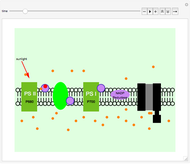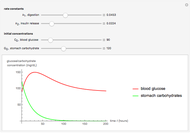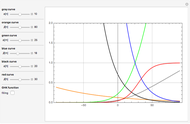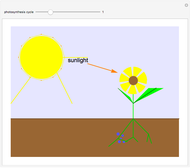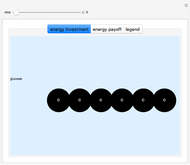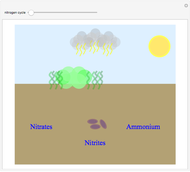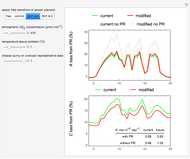Modeling Leaf Photosynthesis and Photorespiration in Current and Future Environments

Requires a Wolfram Notebook System
Interact on desktop, mobile and cloud with the free Wolfram Player or other Wolfram Language products.
This Demonstration uses the leaf model of photosynthesis to predict the response of photosynthesis ( in
in  ; top panel) and the percentage of carbon-fixed
; top panel) and the percentage of carbon-fixed  via photosynthesis lost through photorespiration (bottom panel) throughout the day. The inset in the bottom panel is the total daily integral carbon uptake (
via photosynthesis lost through photorespiration (bottom panel) throughout the day. The inset in the bottom panel is the total daily integral carbon uptake ( ;
;  ). Select the "free" tab to vary the growth environment, allowing for changes in the atmospheric
). Select the "free" tab to vary the growth environment, allowing for changes in the atmospheric  , concentration surrounding the leaf (Ca), increases in temperature above ambient, and choosing between a representative sunny or overcast day. Selecting "control", you can also select predefined conditions representing initial settings as well as two scenarios presented by the Intergovernmental Panel on Climate Change for Representative Concentration Pathway (RCP) of
, concentration surrounding the leaf (Ca), increases in temperature above ambient, and choosing between a representative sunny or overcast day. Selecting "control", you can also select predefined conditions representing initial settings as well as two scenarios presented by the Intergovernmental Panel on Climate Change for Representative Concentration Pathway (RCP) of  for Low Emissions (RCP 2.6) and High Emissions (RCP 8.5).
for Low Emissions (RCP 2.6) and High Emissions (RCP 8.5).
Contributed by: Carl J. Bernacchi, Andy VanLoocke, Berkley Walker, and Donald Ort (December 2015)
Open content licensed under CC BY-NC-SA
Snapshots
Details
This Demonstration uses the leaf model of photosynthesis [1] coupled with temperature corrections [2–6] to model the diurnal response of photosynthesis. The loss of carbon associated with photorespiration is modeled by assuming oxygen is absent in the leaf chloroplast. This Demonstration was created as a supplement to a review article on the costs of photorespiration [7].
The leaf model is parameterized with  of 100,
of 100,  of 180, rate of
of 180, rate of  of 10.5, and an
of 10.5, and an  of 1.5. Details of these parameters can be found in [2, 3].
of 1.5. Details of these parameters can be found in [2, 3].
References
[1] G. D. Farquhar, S. von Caemmerer, and J. A. Berry, "A Biochemical Model of Photosynthetic  Assimilation in Leaves of
Assimilation in Leaves of  Species," Planta, 149(1), 1980 pp. 78–90. doi:10.1007/BF00386231.
Species," Planta, 149(1), 1980 pp. 78–90. doi:10.1007/BF00386231.
[2] C. J. Bernacchi, C. Pimentel, and S. P. Long, "In Vivo Temperature Response Functions of Parameters Required to Model RuBP-Limited Photosynthesis," Plant, Cell & Environment, 26(9), 2003 pp. 1419–1430. doi:10.1046/j.0016-8025.2003.01050.x.
[3] C. J. Bernacchi, E. L. Singsaas, C. Pimentel, A. R. Portis Jr, and S. P. Long, "Improved Temperature Response Functions for Models of Rubisco-Limited Photosynthesis," Plant, Cell & Environment, 24(2), 2001 pp. 253–259. doi:10.1111/j.1365-3040.2001.00668.x.
[4] C. J. Bernacchi, J. E. Bagley, S. P. Serbin, U. M. Ruiz-Vera, D. M. Rosenthal, and A. VanLoocke, "Modeling  Photosynthesis from the Chloroplast to the Ecosystem," Plant, Cell & Environment, 36(9), 2013 pp. 1641–1657. doi:10.1111/pce.12118.
Photosynthesis from the Chloroplast to the Ecosystem," Plant, Cell & Environment, 36(9), 2013 pp. 1641–1657. doi:10.1111/pce.12118.
[5] P. C. Harley, R. B. Thomas, J. F. Reynolds, and B. R. Strain, "Modelling Photosynthesis of Cotton Grown in Elevated  ," Plant, Cell & Environment, 15(3), 1992 pp. 271–282. doi:10.1111/j.1365-3040.1992.tb00974.x.
," Plant, Cell & Environment, 15(3), 1992 pp. 271–282. doi:10.1111/j.1365-3040.1992.tb00974.x.
[6] T. June, J. R. Evans, and G. D. Farquhar, "A Simple New Equation for the Reversible Temperature Dependence of Photosynthetic Electron Transport: A Study on Soybean Leaf," Functional Plant Biology, 31(3), 2004 pp. 275–283. doi:10.1071/FP03250.
[7] B. J. Walker, A. VanLoocke, C. J. Bernacchi, and D. R. Ort, "The Costs of Photorespiration," Annual Review of Plant Biology, forthcoming.
Permanent Citation







